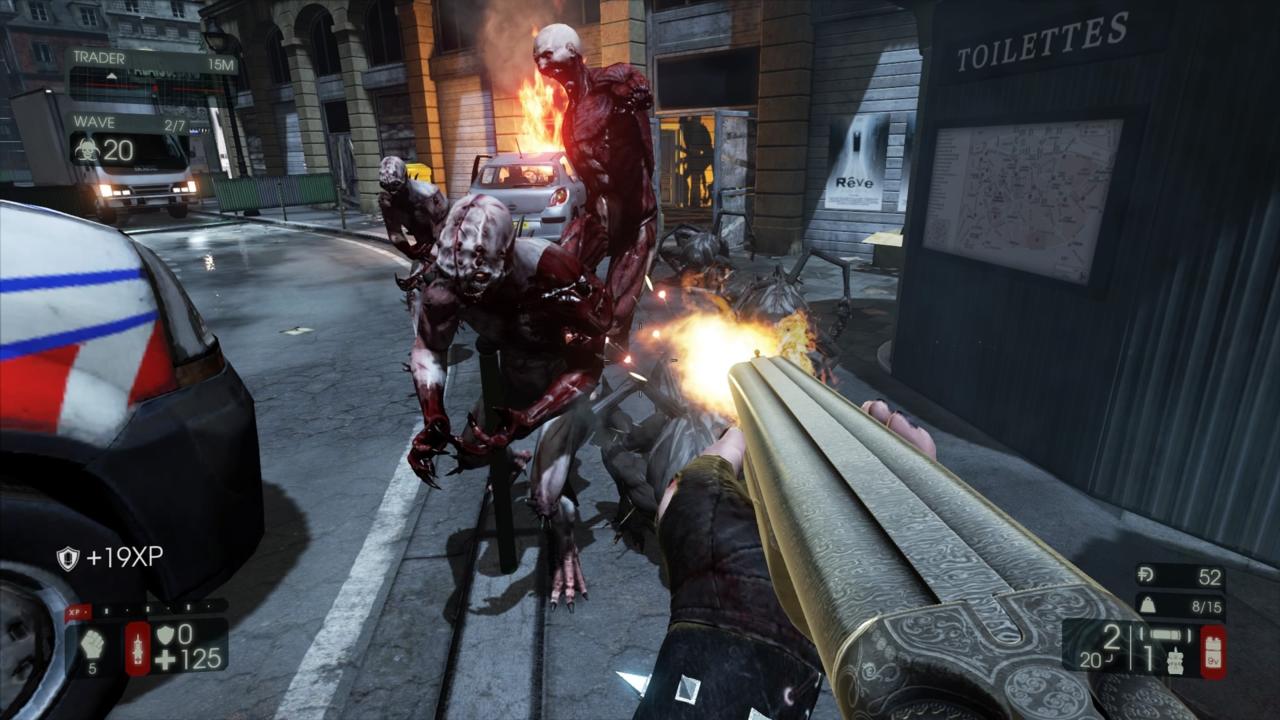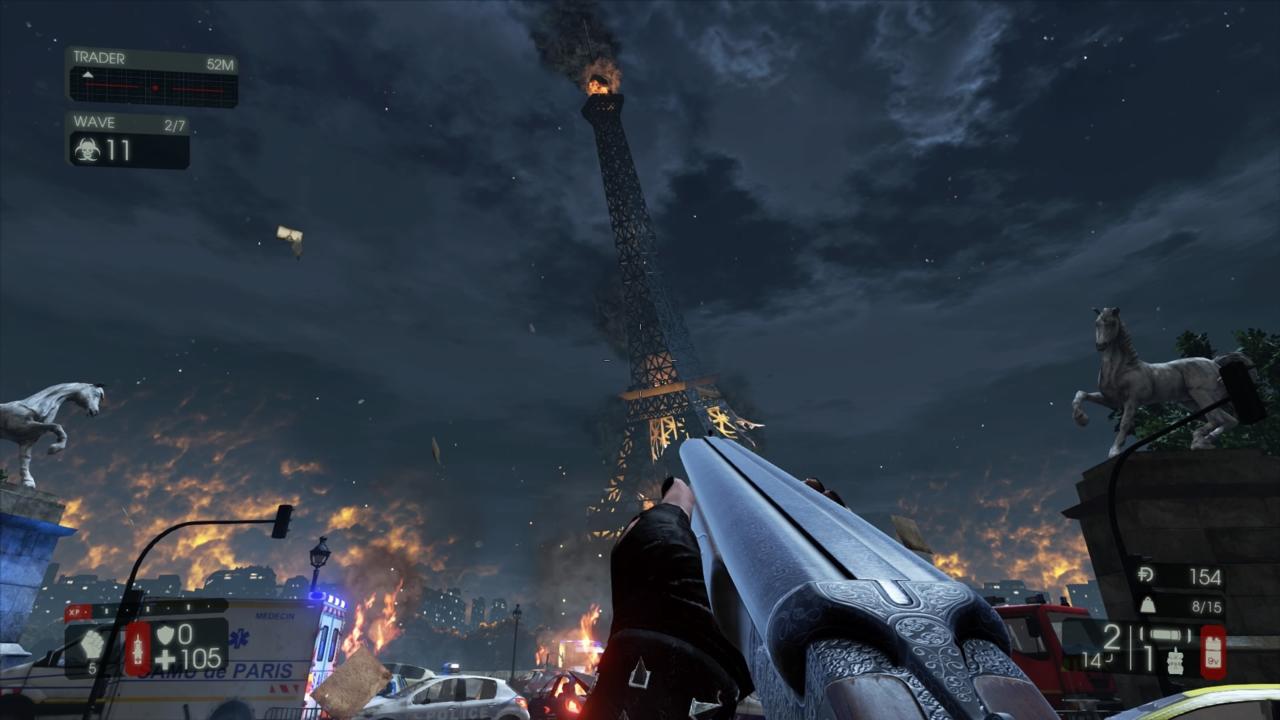As a survival shooter with only two modes, Killing Floor 2 is naturally short on gameplay variety. Yet what it delivers, it does well--namely, uncomplicated, arcade-style zombie shootouts. Staying alive is simply a matter of fending off the undead using whatever weapons you have on hand while effectively managing the space around you. And while its 12 maps are short on objectives and destinations, the drive to stay alive is enough to keep you invested in the action and immerses you in a deep character progression system, which makes your fight consistently enjoyable, especially if you play with teams you can rely on.
While Killing Floor 2's wave-based combat is conceptually reminiscent of Halo's Firefight and Gears of War's Horde modes, the flow of a match is more analogous to Battlefield or Call of Duty. You're not tasked with defending a specific spot (only your team), which means the main skirmish will likely move around the map over time depending where the boss-grade Zeds come from. Whether you're fending for your life in a prison or a dilapidated lab, each layout presents tactical benefits and challenges. Farmhouse, for instance, features an open field where you can see Zeds coming from every direction--the catch is that Zeds indeed come from every direction.
There's thoughtfulness to the maps' designs, which reveal strategic depth after you've gotten familiar with the lay of the land. These layouts present avenues for you to gain the upper hand, as well as some breathing room. But even with a strong position, Zeds continue to pose a meaningful threat. You may feel like a crafty escapee when you jump off a balcony or a mezzanine to create distance, until the moment you realize that Zeds recognize and use these shortcuts as well. You'd pat them on the back if they weren't so eager to kill you.

A couple of distinctly European maps infer the spread of the outbreak. Evacuation Zone is fortified with concrete barriers and barbed wire, while Burning Paris shows an iconic metropolis in ruins. The only map that feels out of place is the Infernal Realm, a gothic underworld dungeon. At least Killing Floor 2's generic death-metal soundtrack matches this locale's hellish vibe. It's a credit to the environmental art designers that the pervasive sights and scenes of ruin makes one wish for more exposition, to learn how the outbreak unfolded. Instead, you have to use your imagination to piece things together, which is a valid approach for a production that primarily focuses on the urgency of each oncoming wave of Zeds.
Just because you can get away with instinctively killing anything that moves does not mean Killing Floor 2 is bereft of depth. Its long-term appeal hinges on its rewarding progression system, which advances your abilities based on your moment-to-moment accomplishments. To gain levels efficiently, it's not enough to simply shoot or slice upon sight. It's about recognizing your character's particular strengths and applying them to undead-infested battles, whether that means serving as a proactive healer or exercising patience while you line up a zombie-stopping headshot. Trying to make every action count in Killing Floor 2 can be an engrossing experience, especially when it benefits your team's success and survival.
Along with skill, progression efficiency also demands thoughtful resource management. How you manage your resources is partly dictated by the diverse mixture of zombies, dubbed "Zeds." It's ultimately pretty basic, but appreciated nonetheless. For instance, a grenade is wasted on a grunt since a well-placed bullet to the head from a basic pistol will achieve the same result. If you have the foresight and patience to save your more powerful rifle rounds, you're rewarded with an easier path to the boss who awaits you at the end of every session. Surviving becomes all the more satisfying when you've completed a round with ammo to spare and enough funds to buy better weapons for subsequent battles.
Win or lose, it's not unusual to end a session feeling a sense of accomplishment, as XP bars fill up when your performance is tallied across multiple classes. Progression in Killing Floor 2 is driven by a clever design that assigns classes to individual weapons rather than a set loadout. That means you can earn experience in both sniper rifle proficiency and healing during a single enemy wave, resulting in XP growth in at least two class categories. This also means your career path in Killing Floor 2 may veer from your original vision or plan.
The perks of each class--which are unlocked as you level up--befit their respective specialities. For example, progress as a Field Medic can lead to greater resistance to toxic bile, while the Demolitionist can improve as a grenade supplier. Every perk is rewarding, especially since upgrades demand a substantial time investment, with new unlocks happening, on average, once an hour.
Once you've gotten familiar with the distribution of enemy types as the waves get progressively harder, it becomes all the more satisfying to adjust your customized loadout to suit the situation. Even if the most efficient weapon isn't necessarily tied to your favorite class, you still feel like an amateur chess player as you try to anticipate what your enemies have planned for the next wave. It's a stimulating case of problem solving when you're weighing ammo potency against the number of rounds you can carry, let alone afford. And while you can be assured that waves get progressively harder in every session, the variety and distribution of Zed types in a given wave are always random, which keeps combat fresh over time.

Killing Floor 2's difficulty dynamically shifts according to squad size, although anything smaller than a team of four feels like a slog, especially after you've experienced the heightened action and faster progression that comes with a full crew of six players. Single-player is a last resort--a lonesome experience--where getting killed immediately ends the current session. It's a stark contrast to multiplayer, where teammates are revived at the start of the wave following their death.
How quickly you rank up depends on how focused you are with one weapon. Killing Floor 2's flexibility in accommodating different play styles--and for those who want to experiment with unfamiliar weapons round after round--is one of the game's strengths. If your tendency is to be a jack-of-all-trades, it would take more than 100 hours to max out these classes, which can be quite an undertaking if you don't have a dependable, skilled team. Such a long span of time reveals Killing Floor 2's repetitive side, which is accentuated by the cast of recycled enemies from the first game.
If the expansive suite of Call of Duty multiplayer modes is analogous to a buffet, Killing Floor 2's offerings are a hearty plate of meat and potatoes. The game hones in on the basic appeal of killing Zombies without the complications of reaching waypoints or setting up intricate fortifications. Yet Killing Floor 2's strongest asset is in its simple yet effective combat--Tripwire could substitute the Zeds for robots or Nazis and still have a solid shooter on its hands.



















